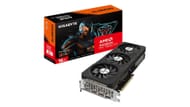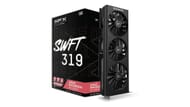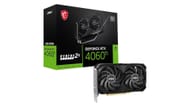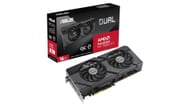16 GB VRAM is quickly becoming the norm for high-resolution gaming, as opting for GPUs with extra video memory allows for peace of mind and future-proofing. AMD and Nvidia have both jumped on this bandwagon and launched multiple GPUs with massive VRAM buffers in the last couple of years.
AMD GPUs offer more flexibility in terms of pricing. You can buy an AMD card with 16 GB of video memory for less than $300. Conversely, Nvidia is a bit more conservative regarding VRAM. All the 16 GB cards from the RTX maker are on the expensive side.
Going forward, it's in your best interest to opt for a card with some extra graphics memory that can allow for future-proofing. We have listed the best GPUs with 16 GB VRAM in this article.
Multiple graphics cards with 16 GB VRAM have launched in 2024
5) AMD Radeon RX 7600 XT ($288)

The AMD Radeon RX 7600 XT is one of the cheapest GPUs with 16 GB VRAM on the market. The card was recently launched as a premium 1080p gaming option. You get the latest RDNA 3 architecture coupled with a massive video memory buffer, which makes it a unique card in the budget range. At this price point, Nvidia only offers 8 GB of video memory with the RTX 4060. This makes it a superb recommendation if you are looking to future-proof your system on a tight budget.
In terms of specs, the RX 7600 XT is based on the cut-down Navi 33 graphics processor. You get 2,048 shading units with the XT version, which is slightly bumped up from the cheaper RX 7600 alternative which uses the same GPU. However, the card isn't as power efficient as the Nvidia alternatives. The RX 7600 XT can draw up to 190W under full load.
Pros:
- It is quite affordable at $329.
- You get competitive rasterization performance with the GPU.
Cons:
- Ray tracing performance of the RX 7600 XT is much worse than the competition.
- Its power efficiency isn't that great.
4) AMD Radeon RX 6800 16 GB ($359)

Despite getting rare these days the AMD Radeon RX 6800 16 GB still sells for a superb price of under $400. The card was initially launched for 4K gaming at a much higher price tag but has recently been discounted to keep it competitive against the latest offerings.
As a high-end video card, the AMD Radeon RX 6800 is stacked with specs. It is based on the Navi 21 graphics processor, which also powers the flagship RX 6900 XT and the RX 6950 XT. Moreover, you get 16 GB of VRAM at 256-bit, making it an upgrade over the 128-bit bus width of the RX 7600 XT. Its power is comparable to the Nvidia RTX 4070.
Pros:
- The RX 6800 16 GB is quite affordable at $359.
- You get 16 GB of 256-bit GDDR6 VRAM with the card.
- The GPU can easily handle games at up to 4K resolutions.
Cons:
- Ray tracing performance isn't up to the mark. You might have to turn the feature off at 4K.
3) Nvidia RTX 4060 Ti 16 GB ($499)

The RTX 4060 Ti 16 GB primarily targets future-proofing for those looking to get the best 1080p gaming experience in the latest titles. The video card is also available with 8 GB VRAM, which costs $100 less. However, the 8 GB option faces serious bottlenecks at 1440p and 4K resolutions, as compared to its 16 GB variant, making the latter the better choice for buyers who prefer to game at 1440p.
In terms of specs, the 4060 Ti 16 GB is almost exactly similar to the 8 GB VRAM variant. You get the same AD106 graphics processor, the same 4,352 CUDA core count, and the same 165W power limit. Only the VRAM buffer has been bumped up to help future-proof the GPU. In terms of performance, the GPU is quite similar to the RX 6700 XT from the last generation.
Pros:
- The RTX 4060 Ti supports DLSS 3 with frame generation.
- The 16 GB VRAM makes the card one of the best for 1080p and 1440p gaming.
Cons:
- The GPU isn't value-for-money at $499.
- Rasterization performance is way behind the competition for the price range.
2) AMD Radeon RX 7800 XT ($499)

The AMD Radeon RX 7800 XT has been launched to compete with the RTX 4070 Super. It is $100 cheaper than the latter and costs about as much as the RTX 4060 Ti. AMD's ray tracing performance has been lagging behind Nvidia's, and this card compensates for that with much better rasterization. At $500, this card delivers the best value for high-resolution gaming.
The GPU is based on the slightly cut-down Navi 32 graphics processor. With 3,840 shading units, the card isn't much faster than the RX 6800 XT. However, the 7800 XT is still a lucrative buy thanks to its competitive pricing.
Pros:
- The AMD Radeon RX 7800 XT delivers significant value for money at $499.
- You get 256-bit 16 GB VRAM with the GPU.
Cons:
- Ray tracing performance, although better than the last generation, can be worse than the weaker RTX 4060 Ti
1) Nvidia RTX 4070 Ti Super ($799)

The Nvidia RTX 4070 Ti Super is one of the latest launches in the market. It replaces the original RTX 4070 Ti with improved value for money thanks to a slightly bumped-up specs sheet. This is one of the most capable graphics cards on the market and easily beats the last-gen RTX 3090 Ti across multiple video games. Moreover, you get DLSS 3 with frame generation. This future-proofs the video card for quite a few years.
The Nvidia RTX 4070 Ti Super is one of the most premium video cards with 16 GB VRAM. The GPU utilizes the GDDR6X memory standard and is based on a 256-bit system. This allows for much higher memory bandwidth as compared to the GPUs listed above. However, it will cost you a pretty penny while being quite power-hungry. You need a capable CPU and power supply to utilize the video card to its fullest.
Read more: 12 GB vs 16 GB: Which is best for gaming?
The GPUs listed above are some of the best options with 16 GB VRAM at the time of writing this article. Given the ever-increasing performance requirements of video games, we won't surprised if Nvidia and AMD launch more such cards in the upcoming days. We are expecting the RTX 50 series and Radeon RX 9000 series video cards this year, and hope to find more performance-focused 16 GB cards to be introduced.
